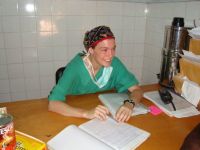Rousbeh Legatis interviews REINOU GROEN of Surgeons OverSeas
UNITED NATIONS, Mar 12 2011 (IPS) – Surgery saves the lives of millions of people around the world, but only a tiny percentage of them live in low- and middle-income countries (LMICs), where a shortage of skills, supplies and infrastructure can turn easily treatable accidents and illnesses into lifelong disabilities and even death.

Reinou Groen Credit: Courtesy of Surgeons OverSeas
The world s poorest receive only four percent of all major surgical operations worldwide, while 75 percent of surgeries benefit the richest third of the world, according to a 2010 Harvard University School of Public Health study.
In the LMICs, people often die instead of being operated on , says Reinou Groen from Surgeons OverSeas (SOS), a New York-based group that improves surgical care in resource- poor environments through training and support programmes.
Recognition of these enormous shortfalls in basic and emergency surgical care is urgently needed at the local, national and international level, underscored the surgeon, who has worked in Niger, the Democratic Republic of Congo (DRC) and Sierra Leone.
Groen spoke with IPS about the problem, why women are especially affected, and how this imbalance affects the U.N. Millennium Development Goals (MDGs).
Related IPS Articles
Excerpts from the interview follow.
Q: You have compared the state of surgery in Sierra Leone today with the U.S. Civil War era (1861-1865). A: Basically we found that the surgical capacity of present- day Sierra Leone is worse off than in the civil war in the 19th century in the USA. Running water was well organised in the U.S., every health facility had a good water supply. In Sierra Leone, we only found two hospitals out of 10 that had running water all the time.
Without running water, sterilisation of surgical equipment and proper hand-washing before operations is impossible. This poses the risks of transmitting diseases. Also electricity is not continuously available in Sierra Leone s hospitals nowadays.
This means for us that we will never go to work without taking a headlamp, since we have needed that more than once during operations.
In our study we have found also that there are only 0.2 government hospital surgeons per 100,000 people in Sierra Leone compared to 300 surgeons per 100,000 Union Army soldiers. While things like open fractures, limb dislocations, and amputations were commonly employed in U.S. Civil War hospitals, they are rarely managed in Sierra Leone.
Q: What does this mean for patients? A: Take knowledge of treatment for open bone fractures as an example, where the bones are exposed without overlaying skin. In Sierra Leone, 80 percent of the hospitals cannot perform good care for open bone fractures. This is due to knowledge gaps and lack of human resources and appropriate material.
As a consequence, an infected bone, so-called osteomyelitis, is a common cause of disability and mortality. The treatment for infected bone, which should have been prevented in the first place by good trauma care, is difficult. Long courses of antibiotics and operations to remove the infected bones are needed to first stabilise the critical condition of the patient.
Thereafter the patient often needs subsequent interventions to reduce disability and a long physiotherapy is needed. This full process can take months or years. One can imagine the cost which comes with this treatment. Initial good trauma care would have prevented this.
And when it comes to costs, there are actually two types: the actual medical costs and the fact that the patient is not able to work in this period of rehabilitation and has no income. This is not affordable for the majority of people in Sierra Leone.
Q: Can you quantify the problem? A: Well, in Sierra Leone there are only 10 surgeons for 5.3 million women, men and children and in Liberia are only three surgeons for 3.5 million people.
There is no reason to believe that these [same] illnesses are not happening in countries where fewer operations are done, it just tells us that people with these diseases are not taken care of and die instead of being operated on. In developed countries emergency surgery is available for everyone, every hour of the day. In the developing world it is currently simply not available.
Q: Do these shortfalls in emergency and essential surgical care affect overarching development strategies like the U.N. Millennium Development Goals (MDGs) (adopted by the international community in 2000)? A: Yes, definitely. There is a strong need to integrate surgery in the existing MDGs, since there are so many related topics and subtopics: The reduction of poverty (MDG 1), child health (MDG 4), maternal mortality (MDG 5) and the fight against HIV/AIDS (MDG 6) will not be achieved if the surgical capacity is not strengthened. To give you some examples:
Five to 10 percent of [pregnant] women or their child will die in labour if they don t get their live-saving Caesarean section. This means that you need a hospital with an operating room with anesthesia and skilled personnel to achieve MDG 5.
According to studies conducted in 2010 in eight low- and middle-income countries (LMICs) – amongst others Sri Lanka, Mongolia, Tanzania, Afghanistan, Sierra Leone and Gambia – this common kind of operation, however, could be done only by 44 percent of rural, community, provincial, or general hospitals and major health centres.
Particularly women will gain from a better surgical care system. If a Caesarean section is available in the hospital, she initially attends to her baby, has more survival chance and she has less risk of developing severe complications when giving birth.